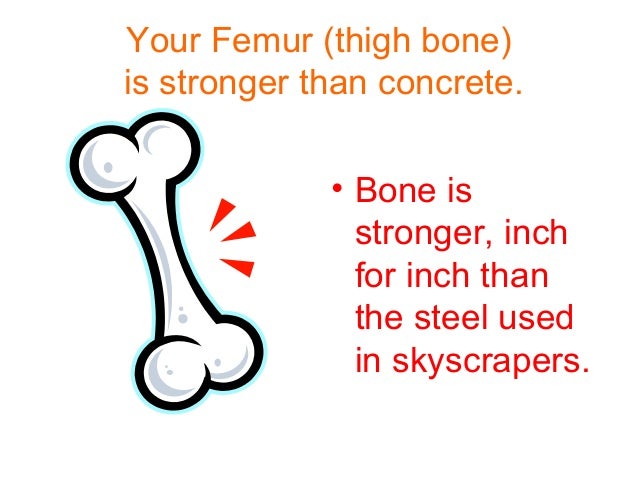Human thighbones are stronger than concrete

Human Thighbones: Stronger Than Concrete?
Are human thighbones truly stronger than concrete? It may seem like an astonishing claim, but scientific research suggests that this statement holds a surprising truth. In fact, when comparing the strength of human thighbones to that of concrete, the former comes out on top.
But how can something as delicate as our bones be stronger than one of the most commonly used construction materials? To understand this fascinating fact, we need to delve into the composition and structure of human bones.
Human bones are marvelously designed to withstand immense pressure and support our body weight. They consist of a complex arrangement of proteins, minerals, and bone cells, which combine to form a sturdy and adaptable framework. The composition of bones is primarily made up of collagen, a fibrous protein that provides flexibility, and hydroxyapatite crystals, which give bones their exceptional strength.
Furthermore, the human thigh contains one of the largest and strongest bones in the body, known as the femur. The femur works in tandem with other bones, muscles, and ligaments to provide support, facilitate movement, and distribute loads throughout the body. It is this intricate interplay of various factors that contributes to the incredible strength of human thighbones.
Concrete, on the other hand, is a man-made material comprising a mixture of cement, sand, gravel, and water. Although it is widely used in construction due to its durability and affordability, concrete does fall short when compared to the strength of our thighbones. Nevertheless, it is essential to note that concrete possesses certain advantages such as its ability to withstand compression forces and its resistance to weather conditions.
So, how can we objectively compare the strength of human thighbones and concrete? Scientists typically utilize a measurement called compressive strength, which quantifies the maximum amount of pressure a material can withstand before breaking. According to numerous studies, the compressive strength of human thighbones ranges from 170-180 megapascals (MPa), while concrete generally possesses a compressive strength of around 20-40 MPa.
This significant discrepancy in compressive strength can be attributed to the dynamic nature of bones. Bone tissue continually remodels itself in response to mechanical stresses, thereby adapting and strengthening over time. In contrast, concrete is a static material that does not possess the same remarkable ability to regenerate and reinforce itself.
It is worth emphasizing that the comparison between human thighbones and concrete is not intended to undermine the value and importance of man-made construction materials. Concrete has revolutionized the field of architecture and engineering, enabling the construction of magnificent structures that shape our urban landscapes. However, this intriguing fact about the strength of human thighbones serves as a reminder of the astonishing complexity and exceptional abilities of the human body.
In conclusion, despite the incredible strength and durability of concrete, human thighbones ultimately surpass it in terms of compressive strength. The intricate composition of bones, coupled with their ability to adapt and regenerate, allows them to withstand extensive pressure. Understanding the remarkable strength of our bones not only highlights the marvels of the human body but also provides valuable insights for medical research and engineering innovation.


Source: positivities.com
Share
Related Posts
Quick Links
Legal Stuff

